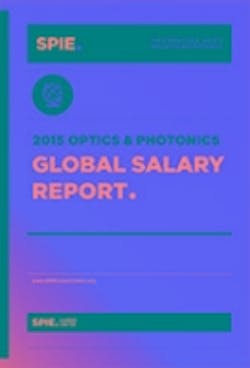Salaries in photonics reflect regional and gender differences
A survey by SPIE finds that salaries in optics and photonics are rising highest in China and median salaries for women continue to lag those of men by around 40%, with the largest gap in late career. The recent survey found that workers in all sectors of photonics report high levels of satisfaction with their jobs. For-profit respondents rate team success as their priority, while academic and government respondents place highest value on scientific discovery.
Among the key findings:
• The median salary is $64,000, down from last year’s $73,000, primarily reflecting large declines of the euro and yen against the dollar. Salary levels vary widely, primarily driven by country income level and employer type.
• Salaries paid in Chinese yuan have risen by 33% since 2012 versus 5% increases in euro, dollar, and yen earnings.
• 55% of workers in lower-income Asian countries expect a raise of 10% or greater in 2015. Only 10% of higher-income Europeans and 11% of North Americans expect raises of that size.
• The highest-paid discipline continues to be aerospace, with a median income of $105,433.
• Workers in industry report higher salaries than those in government or academia.
• Median salaries are 41% higher overall for men than for women, with the largest gap occurring late-career. 49% of women feel that they are paid fairly, versus 57% of men. Wage gaps between women and men persist in most areas, with some exceptions such as academic deans or provosts.
• Survey respondents are highly satisfied with their jobs overall: 85% enjoy their work, 86% find their work meaningful, and 90% respect the work of their peers.
• 37% of workers in higher-income Asian countries work 50 or more hours per week. 28% of Romanian workers report working 55 or more hours per week, the largest percentage of any country.
Survey results are based on nearly 6,000 validated responses from 100 countries. Women make up 16% of the respondents to the survey, roughly mirroring their representation in SPIE membership and at SPIE meetings.
“It is encouraging to see so many anticipate salary jumps in 2015; I hope these expectations come to pass and that we see better remuneration for the scientists, engineers, and manufacturing professionals who are changing our world. They are making a real difference, and should be rewarded accordingly. While the continuing trend of disparity between median salaries for women and men is discouraging, SPIE is heartened by the continued growth of the percentage of women among our membership and conference participants,” said SPIE CEO Eugene Arthurs. “SPIE is committed to providing the crucial exposure and networking opportunities that conferences offer for the many brilliant women in our community. Visibility is invaluable, particularly in the early stages of one’s career.”
Arthurs commended other efforts to help remedy the disparity, such as new European Commission Digital Agenda (DG Connect) rules about female representation in their events. Visibility is key, concurred SPIE Past President María Yzuel of the Universitat Autònoma de Barcelona. “Serving on program organizing committees and giving talks in conferences are very important in developing one's CV," she said. "Role models are important for female students to see that there are high-level women in these fields."
Related article:How to begin a career in photonics
Related article:Top photonics careers and jobs
Source: SPIE
About the Author

Conard Holton
Conard Holton has 25 years of science and technology editing and writing experience. He was formerly a staff member and consultant for government agencies such as the New York State Energy Research and Development Authority and the International Atomic Energy Agency, and engineering companies such as Bechtel. He joined Laser Focus World in 1997 as senior editor, becoming editor in chief of WDM Solutions, which he founded in 1999. In 2003 he joined Vision Systems Design as editor in chief, while continuing as contributing editor at Laser Focus World. Conard became editor in chief of Laser Focus World in August 2011, a role in which he served through August 2018. He then served as Editor at Large for Laser Focus World and Co-Chair of the Lasers & Photonics Marketplace Seminar from August 2018 through January 2022. He received his B.A. from the University of Pennsylvania, with additional studies at the Colorado School of Mines and Medill School of Journalism at Northwestern University.
